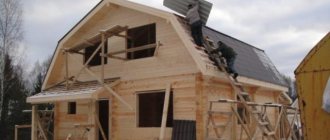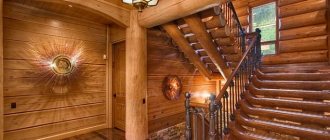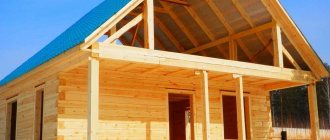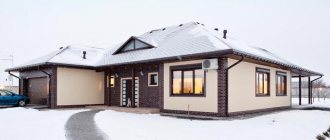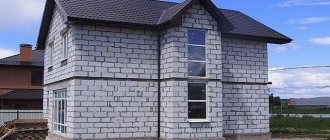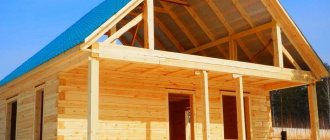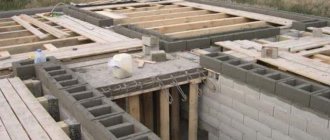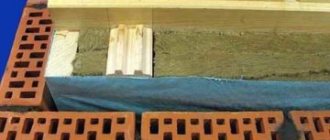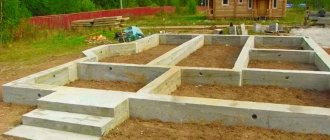Opinions on whether it is profitable to build a wooden house from timber or logs in winter have not yet come to the same denominator. Although it has been repeatedly proven, both in theory and in practice, that this approach is the best when it comes to wood and its properties. An important role is played by the economic factor, which is reflected in changes in demand and, accordingly, the price of a given building material.
However, in order to draw objective conclusions about the benefits and disadvantages, it is necessary to consider both sides of the situation. Therefore, in this material we will pay attention not only to the advantages of winter construction, but also to the difficulties faced by the owners of future, so-called winter wooden houses.
Technological benefits and challenges
In terms of wooden house construction technology, one of the most important factors is environmental humidity. This parameter directly affects wood, since it is a very hygroscopic (well absorbs moisture) material. What exactly depends on air humidity?
- The first is the geometric dimensions of the house kit parts. When wood absorbs moisture, the precisely designed elements of the future log house expand noticeably. As a result, quite serious problems arise with the mating of swollen parts during the assembly of the log house. This problem is especially relevant for construction technology made from profiled timber, since it is more detailed - it has grooves, tenons, and often complex cutouts for corner joints. All this swells and is difficult to put together at the construction site.
- The second is the residual moisture of the lumber. After construction, this same moisture will leave, which will lead to a decrease in the size of the wood. During this period, the well-known shrinkage of a house made of timber or logs occurs, when the walls of the log house sag, changing the original height. The shrinkage will be more noticeable the more residual moisture there was in the wood at the time the frame was assembled.
So, in winter, the ambient humidity is minimal. Accordingly, it has less influence on the geometric dimensions of the house kit parts. They fit together perfectly, are easily mated, and do not dangle after fixing. As shrinkage begins, the wood contains less residual moisture. Accordingly, this process is more predictable and not as intense as in the case of a wet log or timber.
Let's summarize.
Benefits of building a wooden house in winter:
- low air humidity;
- wood does not absorb excess moisture;
- lumber does not change geometric dimensions;
- the process of assembling the log house is simplified;
- the percentage of shrinkage of a wooden house decreases.
Now, for the sake of objectivity, it is worth considering the technological problems associated with the winter construction of wooden houses. Actually, of the big problems here, only one deserves attention - this is the arrangement of the foundation.
The fact is that at subzero air temperatures, working with concrete is quite expensive . To ensure that the water in the solution does not freeze, and the foundation hardens and gains strength, special additives must be added to the concrete. And they cost money. There is another way out - forced heating of the monolith. There are several technologies for doing this, but they are so complex and expensive that they are almost never used in the construction of private houses.
You can solve the problem with the foundation in other ways. The most profitable and simplest of them is to give preference to screw piles. A foundation based on them can be built without any problems in winter, at subzero temperatures. Another thing is that not everyone likes or suits piles.
If so, then the only feasible and break-even way out of the situation is to equip a strip foundation not in winter, but in autumn. Before the onset of cold weather, the monolith will set and gain the necessary strength, which will allow the assembly of the log house to begin in winter. As a result, it turns out that of the technological problems of winter construction, only one point deserves attention. This is the arrangement of the foundation. And since there are a lot of more important advantages, as well as ways to get around difficulties with the foundation, it turns out that it is technologically more profitable to build a wooden house in winter.
Features of winter construction
What you will need to carry out construction work in winter:
- Provide workers with a warm cabin with heating and light sources;
- Take care of heating the concrete; you will need special equipment and possibly the help of specialists. You will also need special additives for the mortar.
- When performing piling work, you will have to work hard; soil development will be necessary (mechanical or heating);
- Special additives to the brickwork mortar will be required, as well as its heating.
- It is necessary to follow special construction technology depending on the material.
Concrete work in winter
The most difficult thing in concrete work in winter is to prevent the mortar from freezing until it has gained the necessary strength. This will require the use of chemical additives that reduce the freezing point of water and accelerate the hardening of concrete, as well as heating the concrete (electric heating, heating with electrodes, infrared heating, the “thermos” method, etc.) It is recommended to maintain a positive temperature of all components of concrete.
Economic benefits and problems
This aspect is quite controversial for the simple reason that it is not relevant for all regions. The point is twofold. Firstly, in some regions there is a pleasant trend associated with winter discounts on construction lumber . It is done by companies due to a decrease in demand for timber and logs during this period of the year. However, such discounts cannot be found everywhere.
Secondly, all because of the same drop in demand in some regions, prices for the services of the builders themselves are being reduced . The benefits are also quite ambiguous. Many construction companies do not reduce their prices for winter services, but rather, on the contrary, increase them, which is more logical. Think for yourself - what is it like for builders in winter, when it’s snowing, frosty and windy outside? Why should their work cost less in more difficult conditions? However, again, in some cases, there is a tendency for prices to decrease. And if it exists, it would be a sin not to use it.
As a result, it turns out that the economic benefits of winter construction of a wooden house remain a big question. Whether this will be a benefit or a costly disadvantage depends on the specific region and the pricing policy of local companies.
Is it possible to build a brick house in winter?
Building brick houses in winter is quite common. The same difficulties arise here as with any winter construction. Therefore, whether to build brick houses in winter is up to you. Things to consider:
- It is necessary to use modifiers to reduce the freezing threshold;
- It is necessary to constantly thoroughly clean the brick from snow and ice;
- As mentioned above, do not heat mixtures with boiling water;
- It is not recommended to carry out facing masonry in winter;
- Use solutions with a grade one or two higher than the design one (depending on the air temperature).
- It is better not to use cement of a grade lower than M500
Logistics benefits and challenges
The last aspect that I would like to include in an objective assessment of the benefits of winter construction of wooden houses concerns logistics. It has been repeatedly said that with the onset of frost, the delivery of building materials to a remote site becomes much easier, since dirt roads freeze and become passable.
Those who say this for some reason forget to talk about snow, which on roads to remote sites is rarely cleared in a timely manner, if at all. Accordingly, during periods of intense snowfall, logistics can turn from a benefit into a serious, and even insurmountable problem.
The second point is the storage of logs or timber at the construction site. The fact is that lumber cannot be piled up, covered with film and kept there until construction begins. If a timber or log is stored in this way, by the time the log house is assembled, even the highest quality lumber will turn into crooked firewood.
To preserve lumber in winter, it must be properly stacked on a platform prepared for this, ventilated in a timely manner, and protected from precipitation. There is a whole official document where everything is described in detail about this. It is recommended that you familiarize yourself with it before purchasing lumber.
Is it possible to build a house from aerated concrete in winter?
Aerated concrete is not the best material option for winter construction. Points to take into account:
- It is necessary to heat the gas blocks, otherwise the water and glue will freeze;
- The gas blocks will have to be watered with almost boiling water, otherwise the water will immediately freeze;
- Do not place gas blocks on ice;
- Do not heat the mixture with boiling water - the cement will lose its properties;
- You will have to keep the glue in a container with thick walls and a lid, otherwise it will quickly freeze. It also needs to be diluted with hot water, but not boiling water;
- Waterproofing of the material is necessary, since moisture inside the aerated block when freezing can damage its integrity.;
- Finishing of aerated block facades is definitely necessary, because... cellular material is afraid of dampness.
Construction in winter - the price of the issue
This is the most important parameter that people pay attention to when planning the construction of a cottage. There is a certain logic to this, based on one’s own feelings. After all, in winter the daylight hours are shorter, which affects the duration of the work of construction crews and increases the time for commissioning of the facility. The low air temperature at which builders have to work also has a very strong effect. And at temperatures below – 20°C, it is generally not recommended to carry out any work on the site, which causes forced downtime in the construction of the building, and, as a result, the need to pay salaries to crews.
A very important characteristic is that there are a lot of holidays during the New Year period - a truly good reason not to start building a cottage, since all work in the country stops for two weeks. But, construction in winter has many positive qualities that offset all of the above and equalize the cost of the house, and sometimes reduce the size of the estimate compared to the summer construction of the building:
- Since no one wants to start construction in winter, all companies are starting to offer discounts on their services in order to eliminate downtime for specialists. That is, you will save on crew work and equipment rental;
- A seasonal decrease in the cost of building materials, which is also observed in winter, as demand can drop by almost half. Therefore, all manufacturers sell the necessary components at a reduced cost;
- Ease of delivery - you will agree that the roads are much clearer in winter than in summer. And dense frozen soil best facilitates the movement of vehicles around the site - no ruts, dug up virgin soil or overturned turf;
- The opportunity to reduce construction time due to the fact that the frozen ground acts as formwork for the foundation, and in the spring the house finally acquires its stable shrinkage. And since wooden houses weigh much less than brick ones, there will be no consequences for the erected structure. Another thing is that you will have to use more expensive concrete with additives, but these costs are also leveled out thanks to seasonal discounts on building materials.
The effect of irregular heating on a wooden house
It remains to be seen what will happen if you rarely heat a wooden house in winter. Without a doubt, such a temperature regime will be the most unpleasant for both the building structures of the building and the finishing done inside, as well as furnishings. The reason for the problems is as follows.
When the air in the house is heated, the frost formed on surfaces inside the building quickly melts. This leads to increased humidity. At the same time, the surfaces of walls, ceilings, floors and even furniture continue to remain cold for several more hours, as they heat up much more slowly than air masses. As a result, condensation forms on them, which takes a lot of time to dry.
Thus, almost all interior surfaces of the house are in direct contact with water for at least several hours. Moreover, this process occurs with every visit of the building owners. In such a situation, various finishing materials, building structures and furnishings react differently, in particular:
- Plastic and glass can easily withstand a large number of “defrost” cycles without any significant negative consequences;
- The effect of moisture on wood depends on the presence of a protective coating. Painted or varnished surfaces do not absorb water, while natural wood, even treated with antiseptics, is likely to get wet. Naturally, this has an extremely negative effect on its characteristics, and also contributes to the appearance of rot, mold and other unpleasant processes;
- The effect of changing temperature conditions on finishing materials is also very different. Wallpaper and putty are likely to simply fall off, the lining may crack, drywall and plaster are highly resistant to such influences;
- Wooden windows and doors, as well as furniture, react extremely negatively to periodic wetting - drying out and deformation of individual parts and elements occurs. Plastic products usually tolerate defrosting without problems.
It is important to note that the more cycles of the “cooling-heating” type occur, the more negative the impact on the wooden house as a whole, as well as individual building structures, decoration and furnishings. The most unpleasant situation in this case is one that involves an increase in the air temperature inside the building, but is not accompanied by a similar heating of the walls, furniture, ceilings and other parts of the building. This occurs when the heating system is turned on for a short time and has the most destructive effect.
As a conclusion, the following should be noted. The optimal temperature regime for operating a wooden house is maintaining the same conditions throughout the year. If this is not possible, it is most advisable to completely eliminate heating of the building in the cold season, taking measures to preserve the building by protecting wooden surfaces from the cold. Periodically turning on the heating has a negative impact on the structure, and the more often it is done, the worse. Particularly destructive is a short-term heating start for 1-2 hours, which increases the level of humidity in the house, but does not lead to sufficient heating of walls, ceilings and furnishings.
